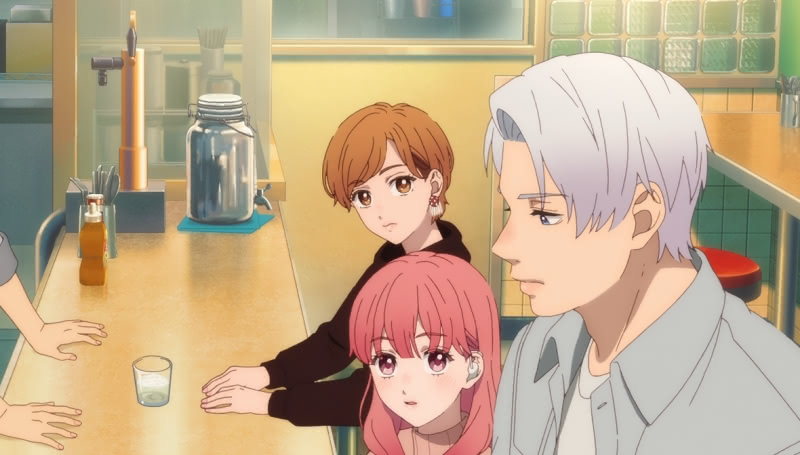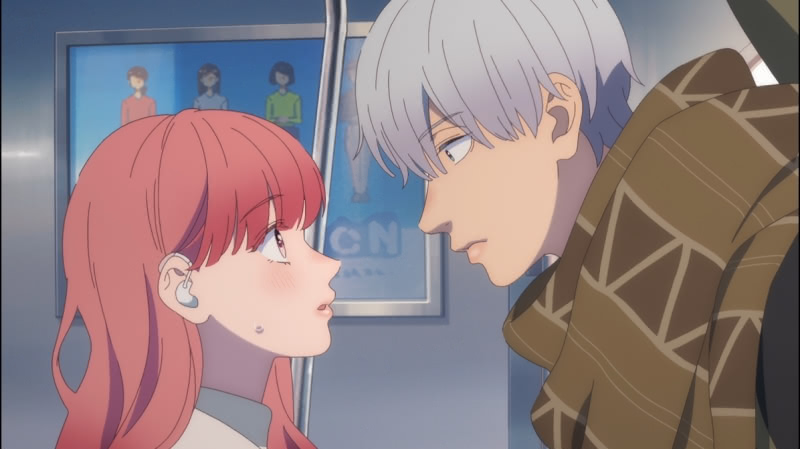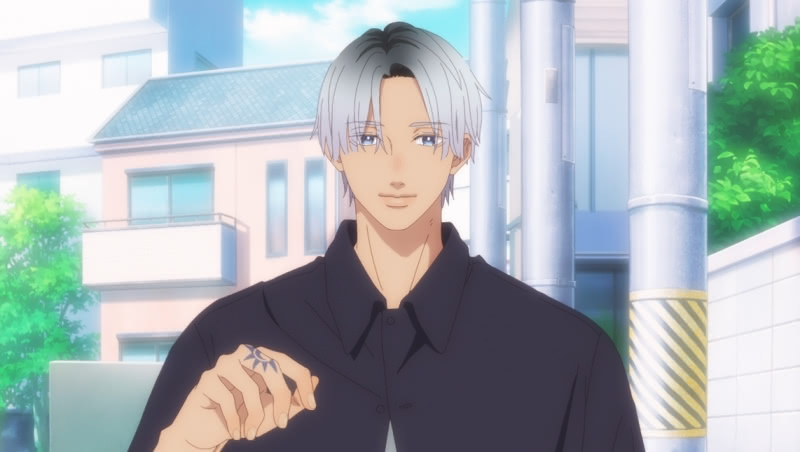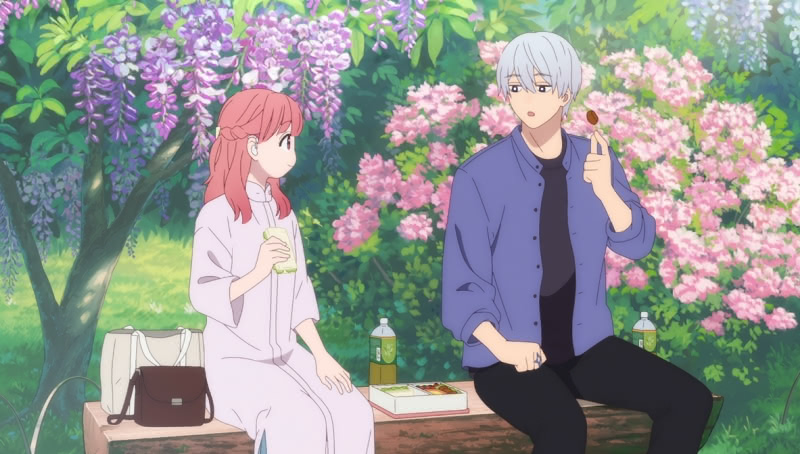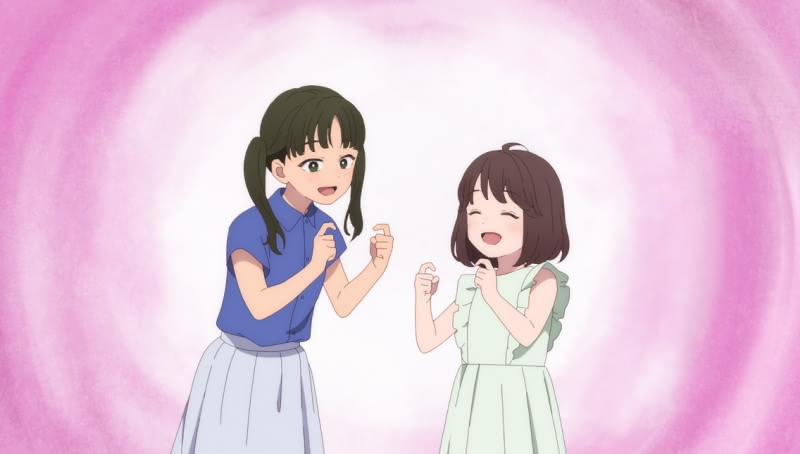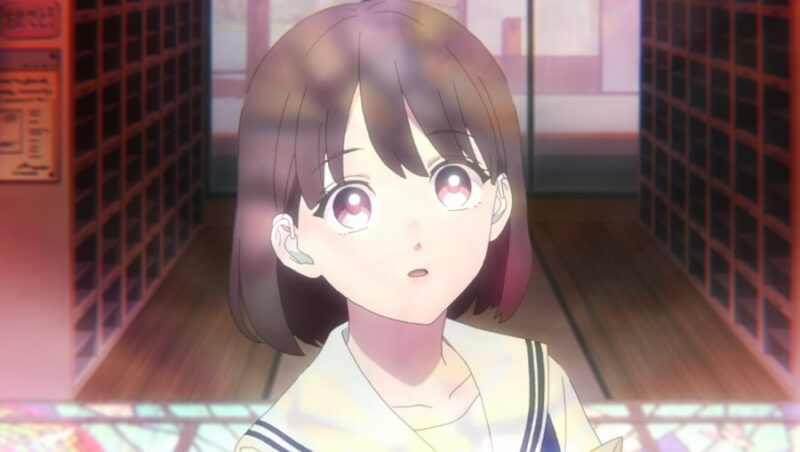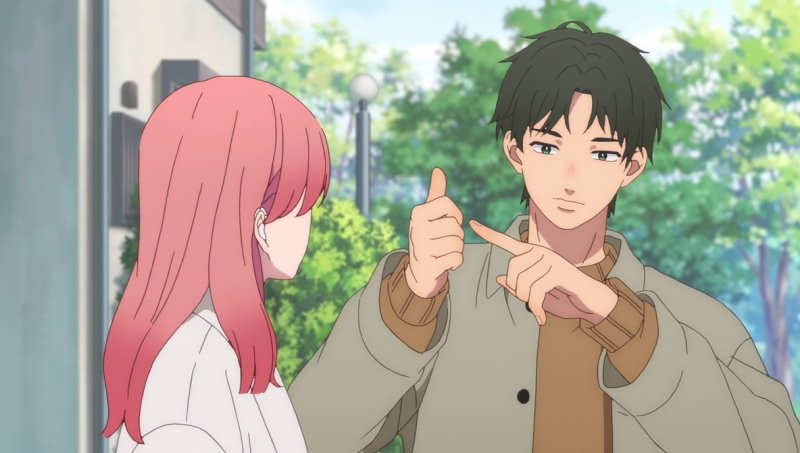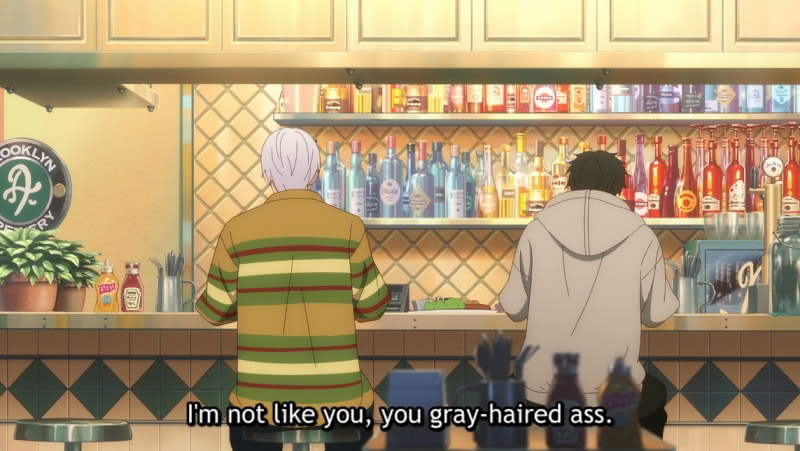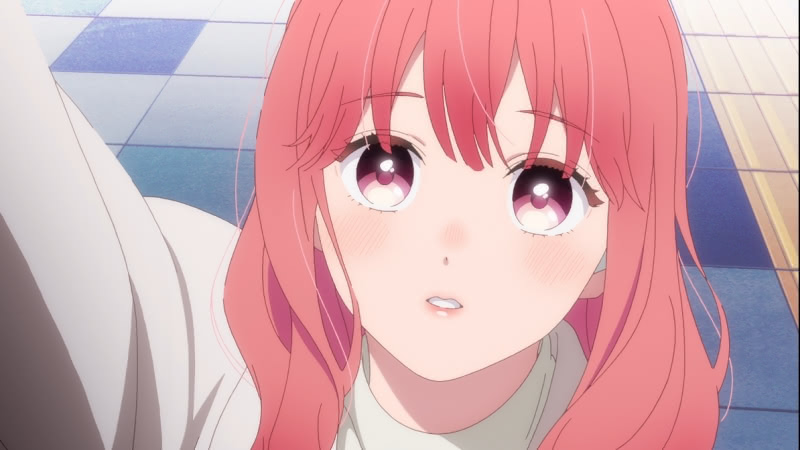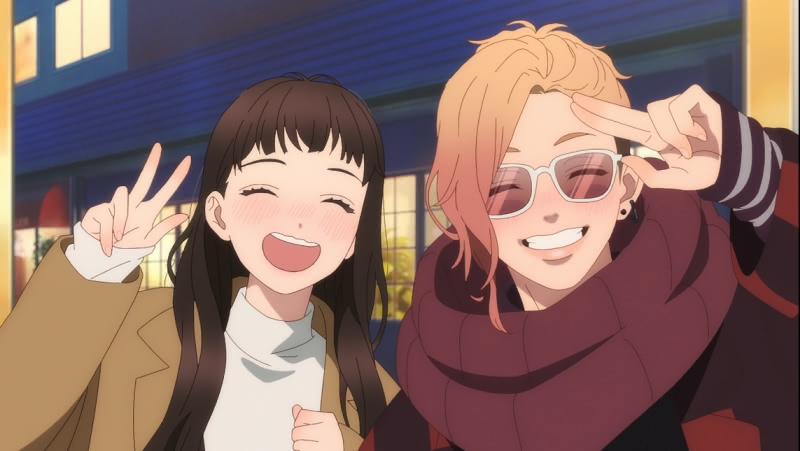I have written six articles about the anime adaptation of A Sign of Affection, which aired for 12 episodes from January 6 to March 23, 2024. The first five articles were about the anime’s remarkably detailed treatment of hair color (see Yuki, Itsuomi 1, Episode 7, Shin, and Itsuomi 2). The sixth and most significant article was my full review of A Sign of Affection. One day after I published my review, I read a different sort of review of the show on Sakuga Blog, a terrific anime website that provides professional-quality insights on anime production and animation with industry perspectives (it has inspired at least one other New Leaf Journal article). I found the Sakuga Blog post very interesting and I ended up learning a great amount about the production of A Sign of Affection. Because I wrote many words about the show and thought the end product was good, I decided to write one last Sign of Affection anime article (barring an unlikely second season) wherein I offer my own commentary on interesting insights from the Sakuga Blog article. I recommend that people read my season review (along with the Sakuga Blog post of course) before reading this article. Because this post does go into enough detail about the show, if you have any inclination to view A Sign of Affection (or read the underlying manga)I would recommend doing so before reading this article.
(Note: I collected all of the screenshots in this article for my previous reports on A Sign of Affection.)
The format of this post will be as follows: Each section will begin with a quote from kViN’s Sakuga Blog piece and then I will offer my thoughts on the quoted passage.
The Manga Authors
Prior to reading the Sakuga Blog piece I had not known that the pen name of the author of the underlying manga was actually the pen name of two authors.
That wasn’t a new issue for the anime adaptation to face, but rather something that the original author was already aware of; or should I say, the original authors, as Morishita suu is a pen name shared by writer/storyboarder Makiro and artist Nachiyan.
I had, however, assumed A Sign of Affection was written by women, although many shoujo pieces are written by men.
I referenced in my own review that I had read the manga (it turned out to be two, of course) and done extensive research into living with deafness in Japan. The Sakuga Blog post describes their research process in detail. I will note that it discusses the relationship of the authors of the A Sign of Affection with Ms. Yuki Miyazaki, who serves as sign language coordinator. I will quote one additional passage about the authors’ relationship with Ms. Miyazaki:
While this explains the how, a very important question remains: what does Yubisaki convey? In a way, those meetings like Miyazaki also helped solidify the concept the authors had in mind. Watching her act like a perfectly ordinary girl drove it home that Yuki the character ought to be more than her condition, that a deaf person is first and foremost the latter.
This comes through in the parts of the manga I read as well as the anime. The only angst we see Yuki go through in the anime relates to her nervousness around her crush. Other than that, she is an ordinary girl who happens to be deaf. For her – deafness is normal since she was deaf from birth, unlike at least one of her classmates from her previous specialized school for the deaf. While her world and experience are necessarily colored by her experiences living with her disability, she never broods over it and instead moves forward and tries new things.
The Genesis of the Anime Adaptation
Some of the most interesting points of the Sakuga Blog piece concern the anime adaptation. For reference, note that Yuta Murano is the director of the anime and Kodansha is the publisher of the manga:
[D]irector Yuta Murano has explained that the project was first pitched to him in a private meeting with Kodansha reps, right after he had led the adaptation of Kakushigoto for them; speaking to Yubisaki’s magazine Dessert themselves in 2023, he placed that meeting 3 years prior, so we know for a fact that the project began in 2020.
The project to turn A Sign of Affection into an anime began all the way back in 2020. We will learn more about this but I will venture that the amount of time that went into the series played a role in the exceptionally detailed final product.
The head writer for the anime is Youko Yonaiyama. Sakuga Blog discusses an interesting tidbit about why Ms. Yonaiyama was a uniquely good fit for the project:
Besides this regular [anime] writing work, she also offers services like teaching sign language or live interpretation for events, which are noted in the same business card she uses within the anime industry—making it clear why she was offered the job.
We learn that Ms. Younaiyama’s parents are deaf – which most likely explains why she learned sign language. Sakuga Blog quotes from an interview with Ms. Younaiyama where she explained that “her personal experience as someone with deaf parents actually makes her somewhat wary of works dealing with that theme [of deafness]…” However, she had apparently previously been impressed with the manga’s attention to detail in depicting sign language and discussing deafness, so she did not need to be persuaded to join the anime project.
Mr. Murano’s Take on what A Sign of Affection is About
Mr. Murano studied the manga series while preparing to turn it into an anime. Sakuga Blog describes an interview he gave about the series and summarizes his views. He understood the manga as not portraying Yuki’s deafness as “inherently tragic” or “pitiful.” Instead, he saw it as portraying Yuki as dignified.
To be sure, he also opined that some media about deafness may focus first and foremost on the “hardships of deafness,” but that was not the focus of A Sign of Affection. But if A Sign of Affection, which features a deaf heroine and references her deafness in its title, is not about deafness, then what is it about? Sakuga Blog describes the views of Mr. Murano and the writers of the manga (note that Yubisaki is part of the Japanese name of the series):
While it stars a deaf protagonist, Yubisaki is not about deafness, but rather about a brave girl approaching a charming globetrotter.
This point of emphasis came across well in both the manga and the anime. The central plot in A Sign of Affection is Yuki, a girl who happens to be deaf, and Itsuomi, a “charming globetrotter,” falling in love. I may differ slightly from my perspective as a viewer in the very Yuki-centric statement of purpose. I noted in my review that I saw Itsuomi, not Yuki, as the main protagonist of A Sign of Affection (referring only to the material covered by the anime adaptation).
This is not a slight to Yuki but instead recognition of the fact that it was Itsuomi’s actions and willingness to take the initiative with Yuki – both in showing an interest in understanding what her world was like and courting her in a way that took into account her limited experience with and frame of reference for romance – that ultimately drove the plot forward. However, I do agree with crediting Yuki for going out of her way to meet Itsuomi, even though she was very nervous, and being much more forthright with herself about her feelings than your typical college-aged anime character.
A Sign of Affection and Communication
There is more in Sakuga Blog’s description of how the manga authors and anime describe the main point of A Sign of Affection. This point is important enough to warrant a separate section.
[Yuki and Itsuomi], one through her sign language and lipreading and the other through his vast experience with foreign cultures, are bound together by their emphasis on communication.
The paragraph goes on to acknowledge that A Sign of Affection is, at its heart, “an idealistic shoujo romance.” It does come across as a shoujo romance with a main character who happens to be deaf – albeit one where the main couple acts with unusual maturity in most episodes. But insofar as it is a shoujo romance, I think communication is the central theme.
A Sign of Affection has numerous characters who have feelings for one another, sometimes of the unrequited variety. The first couple to form in the season is Yuki and Itsuomi. I noted in my review that it is ironic in one sense that Yuki and Itsuomi are the first pair who are able to clearly and honestly convey their feelings to one another, notwithstanding the proverbial language barrier. I say only one sense because I think the contrast between Yuki and Itsuomi and other pairs was intended. The contrast is most clear with respect to Itsuomi’s behavior vs Oushi’s, but I will set that aside for the time being.
Production Centralization
I praised A Sign of Affection for its very careful attention to detail with respect to both the animation and the script. We learn in the Sakuga Blog essay that it achieved this in part through the writer and director both taking unusually (not unprecedented) large work-loads:
For writer Yonaiyama, this was the first project where she wrote every single script; not unheard of, but still quite the achievement, especially considering her role as the sign language supervisor as well. The point where things took a turn for the truly extraordinary, however, was in Murano’s choice to storyboard every episode as well. The director had always wanted to give a try to an effort like this, and Yubisaki’s specific needs made it a challenge worth tackling.
I was most impressed with the animation and cinematography in my review – both of which contributed to my having a more positive impression of A Sign of Affection in anime form than I recalled having had in manga form (Note: I did not read all of the chapters covered by the anime).
While it was the animation and direction that stood out for me, I also praised the script for possessing a similar attention to detail. Granting that A Sign of Affection has a relatively straight-forward script with simple themes and forthright characters, there is aesthetic virtue in something simple executed well.
I quote one additional passage on Mr. Murano’s story-boarding:
In a later Animate Times interview, Murano added that even that wasn’t enough. By storyboarding everything, he could protect the integrity of Yuki’s depiction, ensuring for example that she’s always directly facing someone with whom she’s having a conversation—something that anime will usually play loose with…
It is the aggregation of little things and points of emphasis that made A Sign of Affection as an overall production punch above the weight of its very simple story.
Anime Additions
In both my article on Yuki’s hair color and my overall series review, I singled out one scene in the anime as the best of the series and one of the best scenes I have seen in recent years. Episode two features a flashback scene wherein we see Yuki’s past, from preschool to her many years attending a school for the deaf. While I initially took an interest in the scene because it established that Yuki began dying her hair in college, it is, in all seriousness – strikingly aesthetic. Had I read the manga more recently, I may have noticed something extra about the scene. I quote from Sakuga Blog while using bold for emphasis:
The depth of the research and the attempts to expand Yuki’s world are obvious since the very beginning, with a morning routine chockfull of new details that have allowed hearing-impaired viewers to recognize a life like their own; for example, a vibrating alarm clock waking her up, or flashbacks to a school of the deaf that was not depicted in the manga, complete with visual cues and mirrors in the ceiling for the students who can’t hear people approaching from behind.
My favorite scene of A Sign of Affection was entirely unique to the anime. I suppose that is one way to take advantage of the animated medium to elevate the source material.
Beyond being a beautiful scene – it also added some much needed background for Yuki, especially in light of the fact that one of my small complaints about the anime was the feeling that we did not learn enough about Yuki beyond her attraction to and relationship with Itsuomi.
The Sakuga Blog post goes into more detail, some of it technical, about other ways Mr. Murano worked to use the medium to extend the manga or otherwise adapt things from the manga that would not work as well in the anime format.
Yuki and Oushi
I described Oushi as the one character in A Sign of Affection who is, at times, overtly unpleasant (one’s mileage may vary with Ema Nakasono, Itsuomi’s high school friend who possesses long-held one-sided feelings for him). Oushi is Yuki’s childhood friend. He took up sign language so that he would be able to communicate with Yuki and kept at it on his own until he became proficient. Noting that Yuki’s own family cannot use sign language and Itsuomi, while a quick study, is still a beginner at series’ end, Oushi is the only significant character we see other than Yuki who appears to have full command over sign.
That Oushi has feelings for Yuki is obvious from the perspective of someone watching the anime, but perhaps not to Yuki (for most of the show) on account of the fact that Oushi is often outwardly surly, always over-protective of her, and dismissive of her efforts to take risks and try new things. Oushi is prickly enough that one can forgive Yuki for not putting two and two together about the fact that he initially mastered sign language and kept learning despite having no apparent use-case for it other than talking to her. Sakuga Blog analyzes some of the animation techniques employed in a few Oushi scenes. I will leave describing those to the experts and instead focus on the description of Oushi as a character:
Oushi’s overly protective approach, shrouded in an abrasive attitude, simply never stood a chance with Yuki. His clumsy feelings aren’t only failing to come across, but also fundamentally clash with those aspirations that the imagery hints at. She has been hurt sometimes in the past, but that has never stopped her from dreaming of a colorful life of her own, which little by little she’s been working towards. When Oushi is effectively saying that vulnerable people like Yuki might be better off staying where they’re safe…
Oushi more than effectively said that people like Yuki are better off staying where they are safe – he explicitly said that on one occasion, albeit not to Yuki’s face. But Yuki more than understood that Oushi did not think she was capable of fending for herself even without that explicit statement. One question the anime leaves unresolved – in my opinion at least – is whether Oushi actually thinks that all deaf people should stay where they are safe or whether he was immaturely lashing out because he was possessive of Yuki. I think the latter explanation is more likely. Oushi is specifically frustrated because he cannot express his feelings to Yuki like an adult. The fact that Yuki appears to be getting along well at college – even before she begins dating Itsuomi – shows Oushi that she can manage without his help. When Oushi later in the series evinces some interest in turning his sign language proficiency into a career it suggests to some extent or another that he does not have a categorically negative view of deaf people being out in the world. Alas, the anime was not quite long enough to dig deeper into Oushi’s character and motivations.
When Yuki starts pursuing Itsuomi more proactively in the following episode, another encounter with Oushi furthers that point. The childhood friend’s harsh warnings against going out at night are accompanied by warnings and red lights, whereas her decision to run to Itsuomi is preceded by the traffic lights turning green; he’s the one who encourages her to move forward after all.
I quote this passage not for the excellent visual analysis but instead for the contrast between Itsuomi and Oushi. Oushi first met Yuki because his older sister had taken up sign language and done some work as a student at Yuki’s school. Oushi secretly learned sign language on his own so he could communicate with Yuki. Unlike his sister, who we see as an adult had lost her sign language knowledge, Oushi stuck with it even though there is no indication that he had any occasion to use sign outside of talking to Yuki. Oushi broke down the technical communication barrier he had with Yuki, but simply being able to communicate with her in the way she is most comfortable is different than actually getting to know her. We see in a flashback scene that Oushi first used sign language to call Yuki dumb. To be sure, that was fitting for a young boy with a crush who was not mature enough to fully understand, much less express, his feelings. But when we meet the college-aged Oushi in the anime series, we see that he has not matured much. While he does nice things for Yuki (e.g., reminding her best friend in college to not touch her from behind, saving Yuki at a grocery store when she ended up with a cashier who was wearing a face mask), he condescends to her to protect his own feelings. Worse yet, Oushi sees Yuki as her disability. While Oushi does not get quite enough screen time to fully flesh out his character (Mr. Murano complained that Yuki’s sign conversations with Oushi were particularly difficult to animate – so perhaps this was for the best), one gets the feeling that Oushi sees being able to use sign language as the means to the end of making Yuki rely on him instead of the end of understanding Yuki. Oushi has a set view of Yuki and uses sign to try to impress that view on her.
Itsuomi taks a different approach. After falling in love with Yuki at first sight (more or less), he takes up sign language. One of his motivations is the same as Oushi’s – to make it easier to communicate with Yuki. But Itsuomi has other motivations. We see throughout the show that Yuki can communicate with people who do not know any sign language – namely her mother and her best friend in college. Itsuomi himself is still in the early stages of learning sign language by the end of the show. He makes clear that one of his motivations for learning sign language is so he can understand what Yuki’s life is like and how she sees the world. Moreover, unlike Oushi, Itsuomi has a preexisting interest in languages (he is fluent in English and German) and using foreign languages to get to know new people. While Oushi is still far more adept at using sign language than Itsuomi by the end of the show, it was Itsuomi, not Oushi, who was able to use his interest in sign language to convey his feelings to Yuki and make Yuki feel like he was interested in her as a person.
One final interesting point is that there are some vague signs that Oushi may have had a chance, so to speak, had he conducted himself differently. Late in the season after Oushi more or less accepted his defeat after a clearing the air outing with Itsuomi, he expresses himself to Yuki in a way that, without explicitly stating his feelings, made it obvious enough that Yuki probably figured it out. Oushi, having finally come close to being honest with Yuki, has this reciprocated when Yuki tells Oushi that his being at the same college is comforting because they are long-time friends, she knows he will be there for her if she is in trouble, and he understands her day-to-day challenges. The show does not take a position on whether there was any scenario in which Oushi could have won Yuki over romantically. However, I am inclined to think based on the evidence that had Yuki , for example, made an effort to understand why Yuki wanted to step outside her comfort zone and offered to support her instead of being outwardly condescending, he may have been able to win her heart before her chance encounter with Itsuomi. In the middle of the show, we see Yuki embark on a difficult search for a job because she wanted to earn money to travel with Itsuomi. I had the distinct impression that Itsuomi would have been able and happy to pay for Yuki to travel with him, but assuming this is so, Itsuomi correctly understood that Yuki also wanted to find a job and earn money for her own sake. Instead of telling Yuki her efforts were unnecessary, he offered encouragement and support while she went through a series of rejections. Oushi did not realize until it was too late that all Yuki needed from him was his encouragement and his help if she asked for it.
Outsourcing
Many anime productions outsource the animation of at least some of their episodes to smaller studios. While A Sign of Affection is no exception, we learn that there is nuance to how episode outsourcing took place in its long production:
[I]ts lengthy schedule has allowed them to pull a different trick to bypass the usual shortcomings: making that outsourcing not so full, keeping important tasks within the core team. Despite as many as 5 episodes being subcontracted like that, alleviating the total workload a fair amount, aspects like all the sign language animation and Murano’s personal checks never left in-house premises. While the polish fluctuates a bit across the show as a result, it maintains a beautiful threshold, and never threatens these delicate aspects that the series hinges on.
The director personally story-boarded every episode and that, along with the fact that A Sign of Affection took several years to put together, allowed him to ensure that every episode was of high quality. Moreover, we learn here that all of the sign language animation was handled by the core team, even in the outsourced episodes. I agree that some episodes are more aesthetically impressive than others and there are examples where the show takes shortcuts, but the baseline quality is high.
Anime Aesthetics
In my 2021, 2022, and 2023 anime year-end review articles, I included a specific category award for anime aesthetics. In introducing the category, I made clear that the honor is not strictly for the anime series with the biggest budget and most cutting-edge production values, but for the overall beauty of the show. When I consider anime aesthetics, I consider shows that will age well and still be striking even as computer animation techniques advance. To be sure, sometimes a big budget and team converge with aesthetics – see my 2023 category winner Oshi no Ko as an obvious example. But there are other cases where relatively lightly animated and un-dynamic series stand the test of time. My favorite example is 2006’s Living for the Day After Tomorrow, which received some well-deserved praise for its style but was not recognized among the finest visual efforts of its own day, much less posterity. But from my perspective, its watercolor-infused visuals and soundtrack capture summer more distinctly than any other anime. This make it stand as one of my favorite aesthetic pieces.
Returning to A Sign of Affection, I credited it for having above average production values on a technical level – especially for a romance series (dialogue-heavy romances are not typically known for big budget productions). But while I think it is a technically impressive production, no one would suggest it had more animation or more striking production values than, for example, another winter 2024 series, Frieren: Beyond Journey’s End with its sometimes-theatrical level production values (see Sakuga Blog’s pieces on the animation in episodes 1-4 and episodes 5-10 of Frieren). Sakuga Blog makes note of the sort of production values-aesthetic distinction that I like to make in my anime analysis:
Though a surface examination of Yubisaki might tell you that there are a fair number of seasonal titles with higher production values and more character animation by sheer volume, it’s through consideration like this that I believe it gets elevated to actual character acting. And, combined with all the aforementioned ways that Murano has used to make the world itself convey emotional states and the unique qualities of Yuki’s world, it all comes together with a beauty you’ll rarely find in anime. Its well-meaning story is uncomplicated and nowhere as flashy as most popular titles, but that also helps its clear message come across without any obstacles. Like Yuki’s world, it might not make much noise, but it has a dazzling inner beauty to it.
The key here is the distinction between “production values” and “beauty.” A Sign of Affection has above average production values, but every anime season these days will carry a few shows with higher production values, strictly put. But A Sign of Affection combines the budget it has with terrific visual direction – especially in depicting the appearance and movement of characters – and its attention to detail creates what is, on the whole, one of the most aesthetically impressive anime in recent years. It is, as I opined, the most aesthetically impressive romance anime that I have seen since Blue Spring Ride in 2014.
Final Thoughts
Having liked A Sign of Affection and written several articles about it that proved to be unexpectedly popular here at The New Leaf Journal, I found Sakuga Blog’s deep dive into the series’ production to be quite interesting. If you have read this far without reading the original article, I encourage you to go read it now since I only covered a small selection of the analysis in the Sakuga Blog post.
Barring an unexpected second season, I expect that this will be my last full article on the A Sign of Affection anime adaptation. However, while I already indirectly spoiled that it will not be my choice for anime of the year, not having been the best series of the winter 2024 season, I expect that the show will occupy some position of honor in my 2024 year-end review in December 2024 or January 2025.
